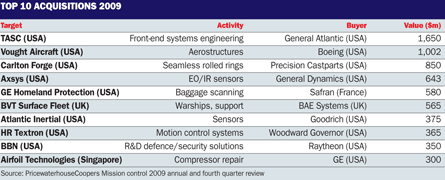No surprise: merger and acquisition activity in the global aerospace and defence industry was down sharply in 2009, sinking to its lowest level - by disclosed value - in a decade.
PricewaterhouseCoopers global aerospace and defence leader Neil Hampson describes the decline to $10 billion last year from a peak of nearly $42 billion in 2007 as disappointing, but the number of deals did not fall off much, as the sector is relatively healthy compared with other industrial product sectors where deal activity crashed.
BACK IN PLAY
As outlined in PwC's 2009 aerospace and defence report, two key factors led to the drop in mergers and acquisitions during 2008 and 2009; finance dried up and companies that were not in financial distress had no reason to sell themselves while prices were low. But, says Hampson, in a possible sign of recovery companies withdrawn from sale in 2008 are starting to come back into play.
Finance remains tight and Hampson says private equity buyers, which accounted for one-third of the M&A market in 2007, were essentially absent last year. Their high-leverage model does not work in a falling market and while private equity players are showing their faces again they will not have anything like as much leverage as before and are cautious. So the M&A market will be driven by corporate buyers with strategic investment priorities.
Another factor likely to drive up the number of deals this year is that it is easier to measure a company's value near the end of a recession than while business levels are plummeting.
 |
|---|
However, Hampson notes that while companies falling into financial distress was the spur for very few sales during the past two years, companies are much more likely to fail on the way out of recession than on the way in. Small companies, he says, are at particular risk of hitting financial trouble as they try to ramp up production after cutting back.
 |
|---|
One possible indicator of trouble to come lies in the halving - to 6.4 times profit - of the sale price to earnings ratio in 2009 compared with 2008 for aerospace and defence deals worth less than $50 million. Hampson cannot say for sure that a drop in underlying profitability has driven that fall-off, but the ratio would drop further if recession lingers.
One of 2009's headline deals was Boeing's $1 billion buyout of key 787 supplier Vought. But Hampson believes that acquisition needs to be seen in the context of Boeing shoring up the supply chain for its marquis programme rather than indicating that manufacturers are looking to reverse their moves to outsourcing: "There's no appetite for pulling things back in-house."
A key M&A driver will be in defence majors extending their reach into homeland security. US and European defence budgets are flat, but there is growth in security as governments look to protect transport, telecommunications, power and other networks from attack. The big question, however, is how those players will extend their reach beyond defence. PwC director Matt Alexander says General Electric's Homeland Protection business, bought last year by Safran, was one of the "few pure plays" in a sector characterised by small, niche companies, so devising an acquisition strategy is not straightforward.
Alexander says the key may prove to be acquiring customer access rather than products or technologies, as selling to, say, the CIA or an energy department is very different than dealing with the Department of Defense.
- Read the report: Mission control - 2009 annual and fourth-quarter review of merger and acquisition activity in the global aerospace and defence industry.
Source: Flight International























